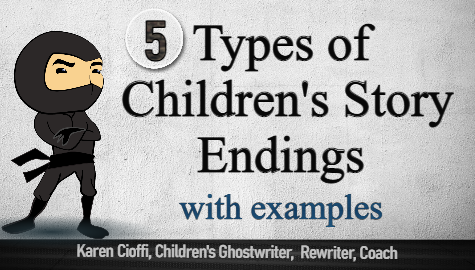Children's stories often end in ways that leave a lasting impression on young readers. These endings can be happy, sad, moralistic, surprising, or open-ended, each providing a unique experience and lesson.
Let's dive into these different types of endings with some classic and contemporary examples.
1. HAPPY ENDINGS
Happy endings are the most common and cherished in children's literature. They leave the reader with a sense of joy and satisfaction, reinforcing the idea that good things happen to good people or that perseverance pays off.
Examples:
• "Cinderella, Disney version." In this classic fairy tale, Cinderella ends up marrying the prince, despite her hardships and mistreatment. Her goodness and kindness are rewarded, and she lives "happily ever after."
• "Charlotte's Web" by E.B. White. After several trials, Wilbur the pig is saved from slaughter by Charlotte's cleverness and dedication. The story ends on a hopeful note, with the birth of Charlotte's offspring, continuing her legacy of friendship and compassion.
2. SAD OR BITTERSWEET ENDINGS
Not all children's stories have happy endings. Some end on a sad or bittersweet note, teaching children about loss, sacrifice, or the complexities of life.
Note: This type of ending may not be suitable when writing for young children, as this age group is not mature enough deal with these emotions. The goal for this age group is to provide a 'happy ending' story.
I feel that children through ten constitute the young age group.
Examples:
• "The Little Match Girl" by Hans Christian Andersen. This poignant story ends with the young girl dying from cold and hunger on New Year's Eve. However, it is bittersweet as she is seen ascending to heaven, free from her suffering.
• "Bridge to Terabithia" by Katherine Paterson is a story that deals with the themes of friendship and loss. The ending is sad as Leslie, one of the main characters, tragically dies. And it’s bittersweet as her friend Jess learns to cope with her loss and keeps her friend’s memory alive.
3. MORALISTIC ENDINGS
Many children's stories are designed to impart moral lessons, often ending with a clear message or moral. These endings aim to teach children about virtues such as honesty, kindness, and bravery.
Examples:
• "The Tortoise and the Hare" by Aesop is a fable that concludes with the moral, "Slow and steady wins the race," teaching children the value of perseverance and humility.
• "Walking Through Walls" by Karen Cioffi is a chapter book that follows the protagonist, Wang, as he tries to gain mystical powers for selfish and unethical reasons. The story underscores the importance of honesty and moralistic behavior. It also demonstrates that it’s never too late to have a change of heart.
4. SURPRISE OR TWIST ENDINGS
Surprise or twist endings can make stories more engaging and memorable by taking an unexpected turn. These endings challenge the reader's assumptions and often leave a lasting impression.
Examples:
• "Caps for Sale" by Esphyr Slobodkina. A peddler of hats decides to take a nap. While sleeping, monkeys take his hats. The peddler yells, stomps his feet, waves his arms, and so on. But instead of giving the hats back, the monkeys mimic the peddler. Finally, in defeat, the peddler throws his own hat down. The monkeys, mimicking the peddler, each throw their hat down to the ground. Surprised but happy, the peddler happily picks them up and goes on his way.
• "The Gruffalo" by Julia Donaldson is a story of a mouse who cleverly uses his wit to scare off predators by inventing the Gruffalo, only to actually encounter the creature. The twist is that the mouse then scares the Gruffalo by convincing it that he is the scariest creature in the forest.
5. OPEN-ENDINGS
Open-ended stories leave some elements unresolved, encouraging children to think about what might happen next or to imagine different possibilities.
These endings can stimulate creativity and critical thinking. They are also a helpful strategy to motivate readers to follow a series.
Some authors even end a story with a cliffhanger to motivate the reader to buy the next book in the series. I’m not a fan of this strategy when writing for children.
Examples:
• "Walking Through Walls" by Karen Cioffi. With Wang’s change of heart, the story ends with him journeying back to the Eternals, leaving readers wondering what will happen when he gets there. This type of ending is an excellent setup for a sequel.
• "Harold and the Purple Crayon" by Crockett Johnson. Harold uses his magical purple crayon to create his own world and adventures. The story ends with Harold drawing his way back to his bed and falling asleep, leaving the possibilities of future adventures open.
SUMMING IT UP
The endings of children's stories play a crucial role in shaping the reader's experience and the story's impact. Whether they’re happy, sad, moralistic, surprising, or open-ended, these conclusions help impart lessons, evoke emotions, inspire imagination, and help make the book memorable.
Understanding these different types of endings will help you use the appropriate ending for the audience.

I’m a working children’s ghostwriter, rewriter, editor, and coach. I can help turn your story into a book you’ll be proud to be the author of, one that’s publishable and marketable.
OTHER HELP I OFFER:
HOW TO WRITE A CHILDREN’S FICTION BOOK
A DIY book to help you write your own children’s book.
PICTURE BOOK AND CHAPTER BOOK COACHING
Four to ten-week coaching programs.
WRITERS ON THE MOVE PRESS.
Self-publishing help for children’s authors.
You can contact me at: kcioffiventrice@gmail.com. Or give me a call at 347—834—6700. (Please leave a message- I’ll get back to you as soon as I can.)


1 thought on “5 Types of Children’s Story Endings with Examples”